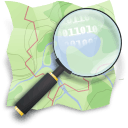iD (software)
iD is a free software online editor for OpenStreetMap (OSM) geodata created in JavaScript and released in 2013. It is designed to be simple and user friendly[5] and is used as a default editor on the main OSM page.
 | |
| Original author(s) | Richard Fairhurst, Tom MacWright, John Firebaugh, Saman Bemel-Benrud, Ansis Brammanis[1] |
|---|---|
| Developer(s) | Multiple contributors |
| Initial release | May 7, 2013[2] |
| Stable release | 2.15.4
/ July 26, 2019[3] |
| Repository | https://github.com/openstreetmap/iD |
| Written in | JavaScript |
| Platform | Web browser |
| Available in | 78[4] languages |
| Type | GIS software |
| License | ISC |
| Website | ideditor |
Usage
Measured by number of users, iD is the most popular OSM editor. As of 2020, an estimated 70% of all OSM editor users were using iD.[6]
iD's features include choosing custom aerial imagery and native support for Mapillary photos.[7]
Some specialized forks of iD:
- Strava Slide, which allows easy optimizing the ways to match GPS tracks collected by Strava users[8]
- iD-indoor, which is intended for indoor mapping[9]
- Mapeo, experimental editor for offline mapping in remote environments[10][11][12]
- RapiD, developed by Facebook as an import tool for reviewing and adding roads detected by proprietary Facebook algorithms[13][14]
History
Prior to iD, the primary web editor for OpenStreetMap data was the Flash-based Potlatch 2 editor.[15][16]. The iD editor project was founded by the author of Potlatch 1 and 2, Richard Fairhurst, online on July 13, 2012[17] and at the State of the Map conference on October 14, 2012.[18]
In September 2012, the Knight Foundation announced the winners of the Knight News Challenge: Data competition. The team from Development Seed/Mapbox was selected as a winner for their proposal to develop new contribution tools for OpenStreetMap, and awarded a grant of $575,000.[19][20]
Name
The choice of iD as a name is related to popularity of getElementById in JavaScript, combination of iPad with Système D, and a tribute to the Citroen iD car model. It was also meant to be easier to spell than Potlatch.[18]
Technical background
This editor was meant to be a Potlatch 2 architecture reimplementation in JavaScript with redesigned user interface. The (only) big internal change was departure from XML tagging preset architecture to a JSON-based one.[18]
While the initial versions were based on Dojo framework,[21] iD now uses D3.js library for rendering and its primary mode of rendering is via SVG. Its core architecture is modular and designed to be easily used in other JavaScript-based tools for OpenStreetMap.[22]
Versions
| Branch | Original release date |
Version | Version release date |
Support Model |
|---|---|---|---|---|
| Alpha | December 21, 2012 | Alpha 3 | February 23, 2013 | |
| Beta | April 2, 2013 | Beta 1 | April 2, 2013 | |
| 1.0 | May 9, 2013 | 1.0.1 | May 10, 2013 | EOL (End-of-life) |
| 1.1 | August 9, 2013 | 1.1.6 | August 23, 2013 | EOL |
| 1.2 | September 26, 2013 | 1.2.1 | September 30, 2013 | EOL |
| 1.3 | October 24, 2013 | 1.3.10 | May 21, 2014 | EOL |
| 1.4 | May 29, 2014 | 1.4.0 | May 29, 2014 | EOL |
| 1.5 | July 8, 2014 | 1.5.4 | July 29, 2014 | EOL |
| 1.6 | October 6, 2014 | 1.6.3 | February 10, 2015 | EOL |
| 1.7 | February 11, 2015 | 1.7.4 | September 16, 2015 | EOL |
| 1.8 | November 8, 2015 | 1.8.3 | December 11, 2015 | EOL |
| 1.9 | March 1, 2016 | 1.9.4 | May 4, 2016 | EOL |
| 2.0 | November 15, 2016 | 2.0.2 | December 22, 2016 | EOL |
| 2.1 | February 4, 2017 | 2.1.3 | February 24, 2017 | EOL |
| 2.2 | May 9, 2017 | 2.2.2 | June 12, 2017 | EOL |
| 2.17 | Dec 23, 2019 | 2.17.3 | April 25, 2020 | Active |
| 3.0 | N/A | 3.0 | N/A | Alpha Development |
References
- iD: The easy-to-use OpenStreetMap editor in JavaScript, OpenStreetMap on GitHub, 2017-10-21, retrieved 2017-10-22
- Firebaugh, John (7 May 2013). "New Map Editor Launches on OpenStreetMap.org". Mapbox. Retrieved 6 November 2016.
- https://github.com/openstreetmap/iD/releases
- https://github.com/openstreetmap/iD/tree/master/dist/locales
- "OpenStreetMap launches all-new easy map editor and announces funding appeal". OpenStreetMap blog. 7 May 2013. Retrieved 6 November 2016.
- https://wiki.openstreetmap.org/wiki/Editor_usage_stats#by_number_of_users_.28distinct_uids.29
- https://wiki.openstreetmap.org/wiki/Comparison_of_editors#iD
- http://labs.strava.com/slide/
- https://git.framasoft.org/PanierAvide/iD-indoor
- Halliday James (9 June 2016). "OpenStreetMap Without Servers [Part 2] A peer-to-peer OSM database". Retrieved 18 July 2016.
- https://github.com/digidem/mapeo-desktop
- MacLennan, Gregor (22 July 2016). "Technology Preview: Participatory mapping in the Amazon with Mapeo". Retrieved 11 August 2016.
- "RapiD". OpenStreetMap Wiki.
- "mapwith.ai".
- https://wiki.openstreetmap.org/wiki/Comparison_of_editors
- https://blog.openstreetmap.org/2009/11/30/introducing-a-new-osm-editor-potlatch-2/
- https://blog.openstreetmap.org/2012/07/13/building-a-friendly-editor-for-openstreetmap/
- https://web.archive.org/web/20121023145335/http://www.systemed.net/blog/index.php?post=24
- https://www.knightfoundation.org/press/releases/six-ventures-bring-data-public-winners-knight-news
- https://blog.mapbox.com/large-investment-in-openstreetmap-from-knight-foundation-cf7aa00534db
- https://www.mapbox.com/osmdev/2012/10/25/diving-into-id/
- https://github.com/openstreetmap/iD/blob/master/ARCHITECTURE.md
